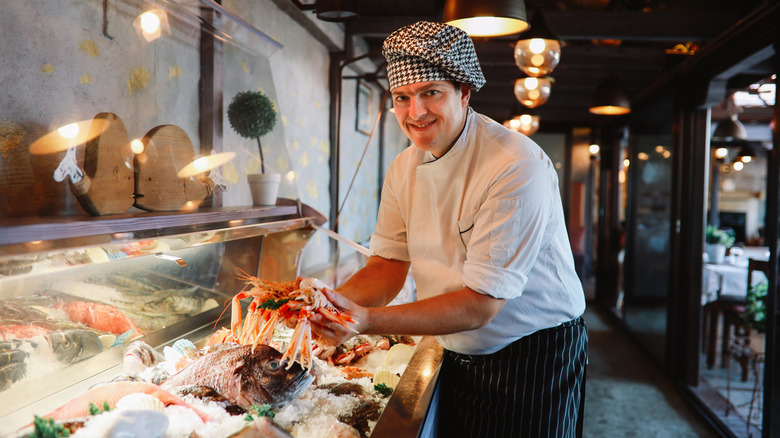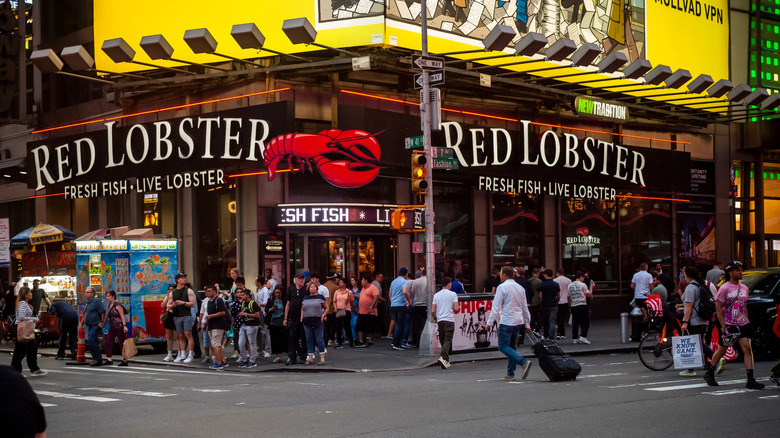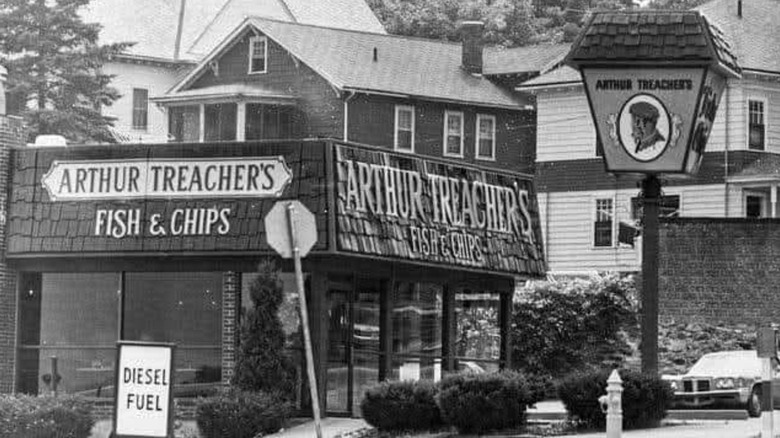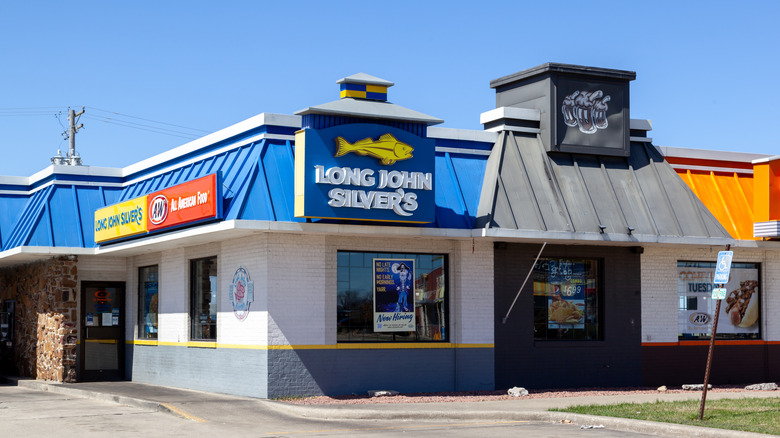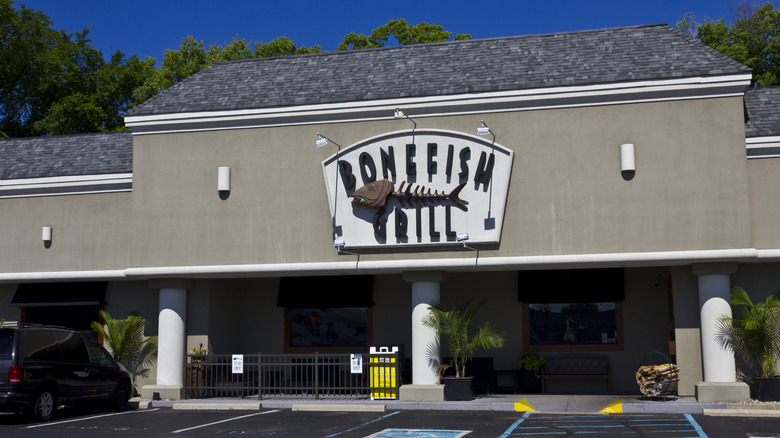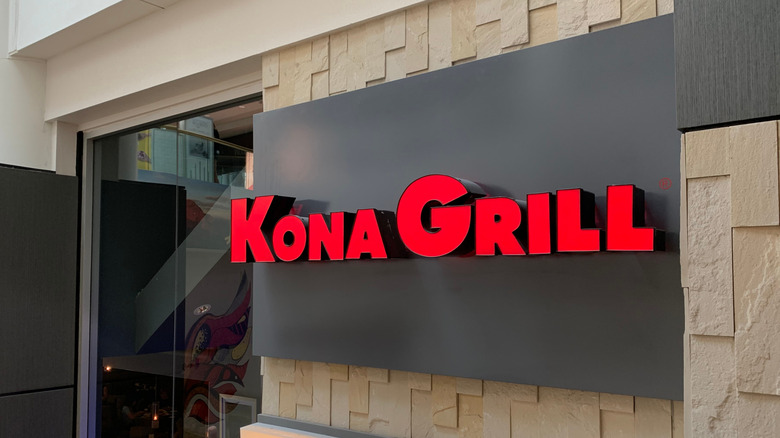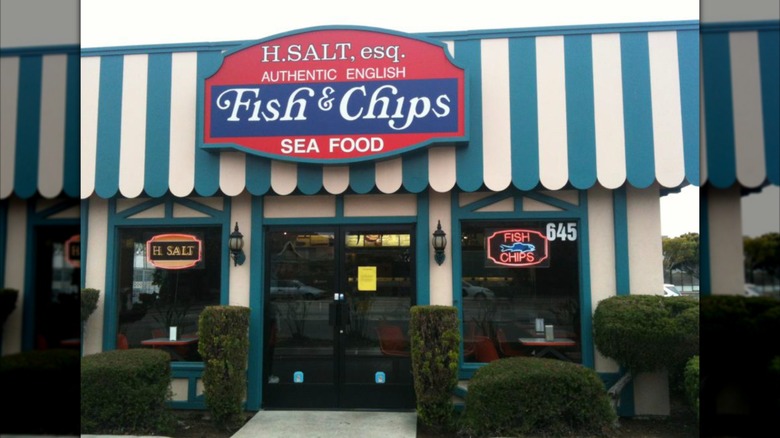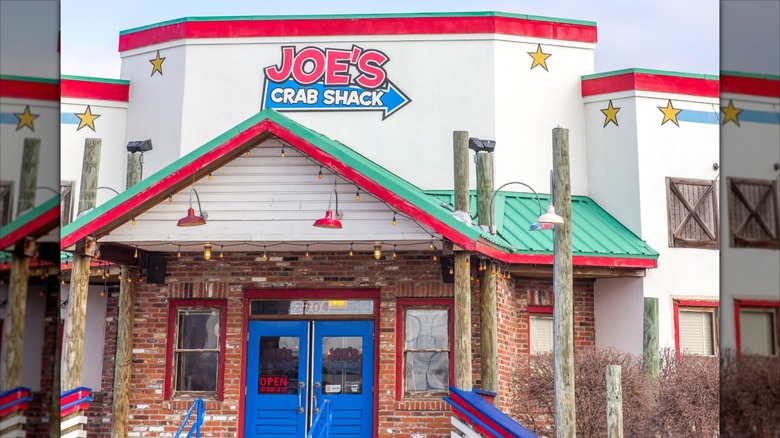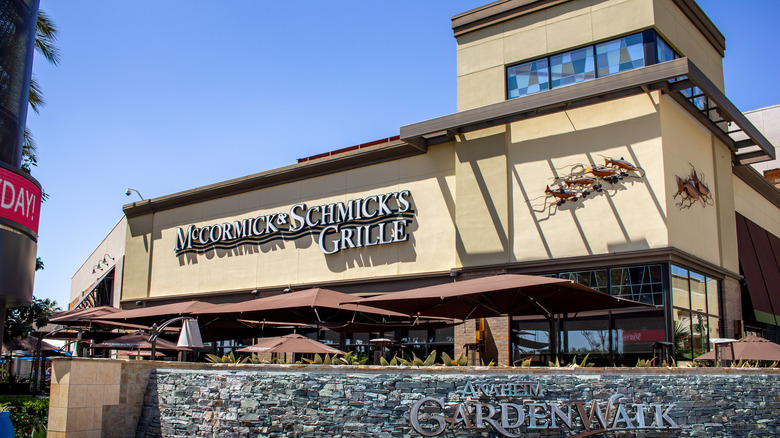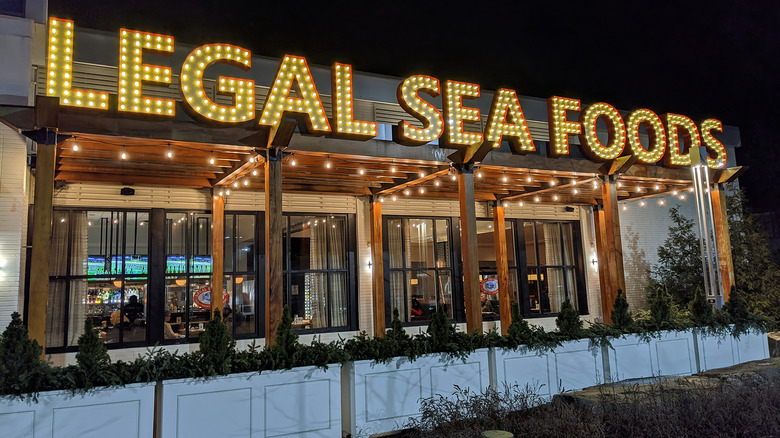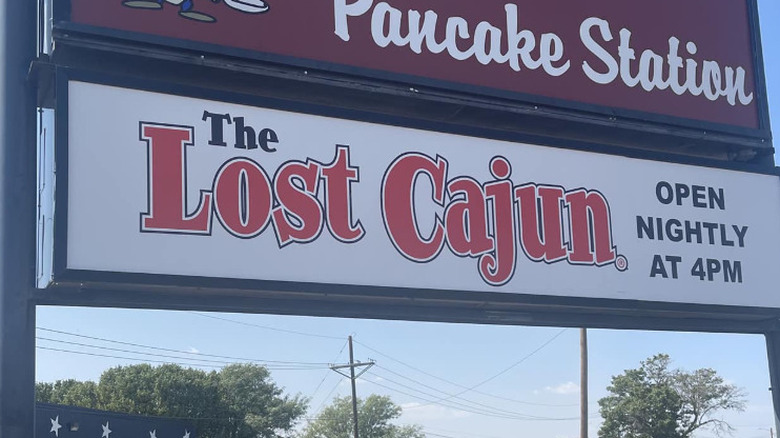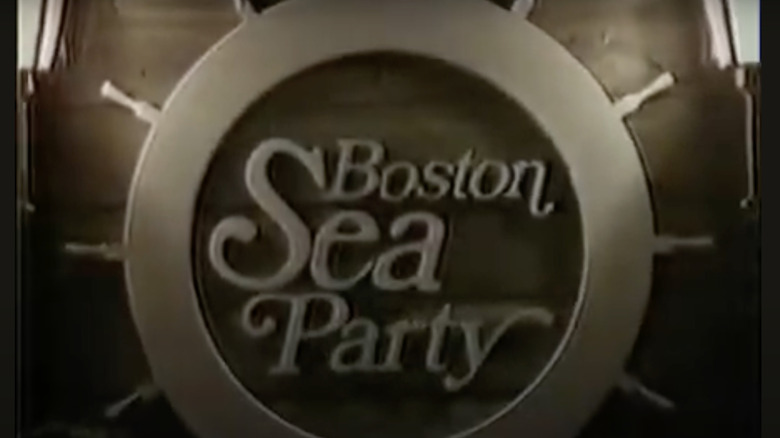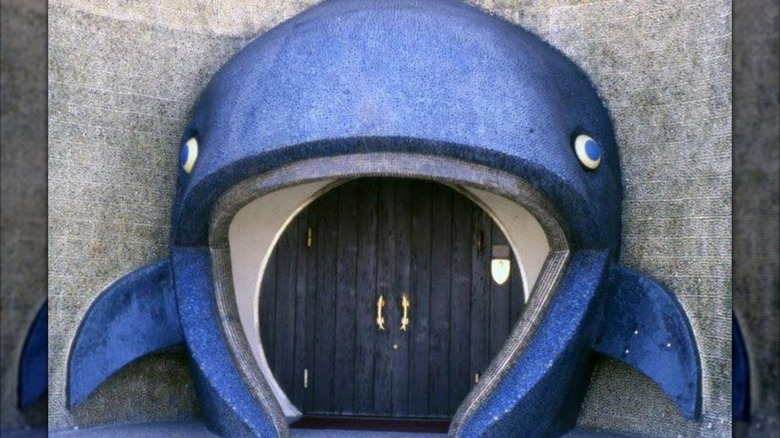10 Seafood Restaurant Chains That May Soon Be Gone Forever And 2 We've Already Lost
From lobster bisque to crispy salmon and fried shrimp, seafood offers a range of flavors and textures that appeal to a wide variety of taste preferences. As such, coastal bounty attracts both casual diners and gourmet enthusiasts alike. It's not surprising, then, that seafood consumption in the U.S. increased by 20% in 2024, with many Gen Z diners opting for more seafood options (via SeafoodSource). Unfortunately, a surge in interest doesn't always translate to higher foot traffic at casual dining establishments.
According to Insight Trend Worlds, the casual dining scene in the U.S. has been facing significant pressures, with restaurant prices increasing by 34% since 2019 — surpassing overall inflation. The seafood chain restaurant sector has also experienced its share of challenges, as many consumers shift toward faster, more affordable dining options. While some seafood chains have managed to adapt to changing customer demands, others haven't fared so well, filing for bankruptcy and closing multiple locations.
Curious about which seafood restaurant chains are struggling to survive and which ones have already closed their doors? Keep reading!
Red Lobster
Red Lobster filed for bankruptcy in May 2024, citing a debt of over $1 billion and less than $30 million in cash reserves. Rather than being a result of one bad decision, it seems that the chain fell victim to a string of costly errors and operational mismanagement. After all, who could forget Red Lobster's endless crab promotion in 2003, which set the company back $3.3 million in seven weeks? Red Lobster didn't seem to learn from its mistakes either — the chain ended up losing $11 million after turning its $20 endless shrimp promo into a permanent menu option in 2023. Despite its marketing efforts, Red Lobster saw a 30% decline in the number of patrons between 2019 and 2024.
Founded in 1968, the chain experienced peak popularity in the 1990s with more than 700 restaurants in operation. However, this success wasn't about to last. In an attempt to save the company, Red Lobster closed more than 50 locations in 2024. In mid to late 2024, the chain was acquired by RL Investor Holdings LLC, an entity led by Fortress Investment Group, which committed over $60 million to inject new life into the brand. It remains to be seen whether this infusion of capital turns things around for the seafood chain.
Arthur Treacher's Fish & Chips
Perhaps one of U.K.'s most famous exports, fish and chips is as simple as it is delicious. Pairing battered fish with thick-cut fries (or chips, as they are known in the U.K.), the classic duo often comes with a side of mushy peas. Just as its name suggests, the dish is the star of the menu at Arthur Treacher's Fish & Chips. Established in 1969 in Columbus, Ohio, by several investors including Wendy's founder Dave Thomas, the restaurant was named after English actor Arthur Treacher, best known for his roles as an English butler.
At the height of its popularity in the 1970s, Arthur Treacher's boasted more than 800 locations. Today, the chain is down to just three locations in Ohio, with the Cleveland Heights restaurant only opening in 2025 on the site of a former Arthur Treacher's. This begs the question — what exactly went wrong? There were several reasons for the chain's decline, including the "cod wars" between the U.K. and Iceland, which increased the price of the restaurant's main ingredient.
In 2021, Nathan's Famous — which acquired the rights to co-brand Arthur Treacher's products in 2002 — announced that it was planning to relaunch the chain as a virtual, delivery-only brand. The venture aimed to offer the restaurant's classic menu items plus a few new additions in partnership with Franklin Junction. To date, the partnership has led to the opening of over 150 virtual restaurants, suggesting that Arthur Treacher's may not be entirely out of the seafood game yet.
Long John Silver's
Long John Silver's was once a casual dining concept to be reckoned with. In the period between 1979 and 1989, the chain boasted around 1,500 locations, riding the wave of America's love for deep-fried comfort food. However, this success story wasn't destined to last, with the chain gradually downsizing to just over 480 locations.
Part of the problem could have been the restaurant's menu, which gradually fell out of favor with health-conscious consumers. Notably, in 2013, the Center for Science in the Public Interest named the chain's The Big Catch the "The Worst Meal in America." Consisting of fried fish, hushpuppies, and onion rings, the meal contained 33 grams of trans fat, 19 grams of saturated fat, and 3,700 milligrams of sodium. Unsurprisingly, the chain quickly removed this artery-clogging option from its menu.
Having once held two-thirds of the fast food seafood market share, Long John Silver's began losing momentum as larger companies started entering the scene. Faced with growing debt, the chain was purchased by private investors in a $620 million deal in 1989. Despite the change in ownership, the company ended up filing for bankruptcy in 1998. Long John Silver's subsequently changed hands several times, even becoming part of a portfolio that included A&W Restaurants and Yum! Brands. Unfortunately, the overhauls failed to restore the chain back to its former glory.
Bonefish Grill
The year 2024 proved to be a challenging one for Bonefish Grill. The seafood restaurant chain, which is part of the Bloomin' Brands restaurant group, reported a declining performance in the third quarter of the year. More specifically, this period saw the chain's foot traffic drop by 10% and sales by 4.1% compared to the same period in 2023. The fourth quarter of the year wasn't much better, with Bloomin' Brands laying off 100 employees and announcing plans to reduce the menu size at Bonefish Grill, as well as at several of its other restaurants, including Outback Steakhouse and Carrabba's Italian Grill.
This wasn't the first time Bonefish Grill found itself in financial trouble. In 2016, Bloomin' Brands revealed plans to close 14 of the 210 Bonefish Grill restaurants over the next three years, citing weak performance. By 2022, the number of locations had dwindled to 185. Today, Bonefish Grill operates just 166 restaurants, with the greatest presence in Florida, North Carolina, and Pennsylvania. In 2025, Bonefish Grill launched a new menu to breathe life into the struggling chain — whether this strategy works remains to be seen.
Kona Grill
Founded in 1998 in Scottsdale, Arizona, Kona Grill serves American and Asian dishes, with a focus on meat, seafood, and sushi. During its first two decades, the chain expanded rapidly, growing to 46 locations by the end of 2017. In fact, Kona Grill doubled its number of restaurants in just four years from 23 locations in 2013. While this may have seemed like a success, the aggressive expansion led to mounting debt, with each location opening setting the company back by $4 million. It certainly didn't help that the restaurant's customer numbers and sales started to decrease in 2015.
In 2019, Kona Grill filed for bankruptcy amid rising debt, which amounted to $33.2 million at the time of the announcement. The company had already closed four restaurant locations in 2018 and initiated cost-cutting strategies that reduced investments in staff training and menu development. In 2019, Kona Grill was acquired by The ONE Group for $25 million, along with $11 million in assumed liabilities. At the time, the chain had dwindled to just 24 restaurants. The timing of the acquisition proved unfortunate, with the COVID-19 pandemic disrupting the chain's operations. Today, there are just 27 Kona Grills in the U.S., with the chain's long-term prospects still in doubt.
H. Salt Esquire Fish & Chips
Founded in 1965 by Haddon Salt and his wife Grace, who immigrated to the U.S. from the U.K., H. Salt Esquire Fish & Chips specializes in what its name suggests — fish and chips. The first location opened in Sausalito, California, quickly gaining popularity and expanding its reach throughout the state and further afield. Realizing that he needed a partner to scale the business, Salt sold his company to Kentucky Fried Chicken in 1969, effectively becoming the third-largest shareholder in the corporation.
Over time, Salt realized that KFC wasn't really interested in continuing his restaurant concept. Instead, the fast food giant changed H. Salt Esquire's menu, compromising the quality of the ingredients. Salt also wasn't happy that KFC was trying to turn him into another Colonel Sanders, a marketing tactic that would transform him into the chain's mascot. Not surprisingly, KFC and Salt parted ways in 1973, and 14 years later, KFC sold the brand. Today, H. Salt Esquire Fish & Chips continues to sell "non-greasy" fish at its one remaining location in Orange, California.
Joe's Crab Shack
Founded in Houston in 1991, Joe's Crab Shack grew quickly, opening three restaurants locally and another in Dallas within just four years. By 2009, the chain had changed hands, ultimately landing under the ownership of Ignite Restaurant Group, formerly known as JCS Holdings. At the time, the chain was operating 130 Joe's Crab Shack locations across the U.S. However, this would prove to be the peak of the chain's growth, with the following years bringing declining sales and restaurant closures.
In 2017, Ignite Restaurant Group filed for bankruptcy, closing more than 40 Joe's Crab Shack locations, with the brand disappearing completely from Indiana and Michigan. That same year, the chain experienced a sharp financial decline, with sales falling by 14.3% in the first quarter, and a revenue decrease from $96.2 million to $76.1 million. These losses no doubt contributed to Ignite Restaurant Group being delisted from the Nasdaq Stock Market in March 2017. Today, Joe's Crab Shack is down to just 18 locations, a sure sign that the chain may not be around for much longer.
While there may not be a single reason for Joe's Crab Shack's decline, the brand's outdated concept and operational missteps likely contributed to the drop in customer traffic. Some of the problems that hurt the chain included its continued use of trans fats, despite pledging to eliminate them several years earlier. Joe's Crab Shack's no-tipping policy was also a massive failure. In 2015, the chain implemented a no-tipping model at several restaurants, raising menu prices to cover higher wages — a decision that proved hugely unpopular with diners.
McCormick & Schmick's
Despite the claim that the chain serves "the most sustainable fish," McCormick & Schmick's hasn't exactly been killing it in the sustainable growth department. In fact, the upscale seafood chain has been closing restaurants since it was purchased by Landry's Inc. in 2011.
At the time of the acquisition, Landry's CEO, Tilman Fertitta, said that McCormick & Schmick's simply grew too fast amid a recession. The chain "fell victim to the need to grow and located some restaurants in secondary markets which were adversely impacted to a greater degree by the economic downturn" (via Oregon Live). Fertitta also noted that while McCormick & Schmick's could eventually expand to 90 restaurants, it would probably have to downsize first — and downsize it did.
When Landry's Inc. acquired McCormick & Schmick's in 2011, the chain had more than 80 restaurants in 26 states and Canada. The following year, Landry's Inc. shuttered a few restaurants. It wasn't long before more establishments were closed, including the long-standing restaurants in San Diego's Omni Hotel and in the Town Center section of Virginia Beach, both of which closed in 2020. As of this writing, there are only 20 McCormick & Schmick's locations remaining.
Legal Sea Foods
Legal Sea Foods got its start as a fish market stall in 1950, where you could feast on a haddock dinner for 89 cents. The first Legal Sea Foods restaurant debuted just beside the market in 1968. The venture was a success, and by 2001, Legal Sea Foods boasted 25 locations along the East Coast. In 2020, the chain was acquired by PPX Hospitality Brands, with the son of the restaurant's founder, Roger Berkowitz, retaining control over its e-commerce business.
Legal Sea Foods was never a huge operation, with the chain reaching a peak of 35 locations in 2019. However, instead of growing, the string of restaurants has gradually contracted, facing challenges similar to those of other casual dining ventures, including changing consumer habits, rising costs, and the fallout from the COVID-19 pandemic. Today, Legal Sea Foods has dwindled to 25 locations, with the greatest presence in Massachusetts, and single locations in Illinois, New Jersey, and Rhode Island.
The Lost Cajun
The first Lost Cajun opened in 2010, bringing Southern-style cooking to Frisco, Colorado. Despite offering just four menu items, the restaurant proved successful, growing to 24 locations in six states within the next decade. Over this period, The Lost Cajun also expanded its menu of Cajun classics to include the likes of lobster bisque, gumbo, fried seafood, and jambalaya. Standing testament to its potential, the venture was even named one of "The Top 50 Emerging Restaurant Chains" at the time. Things were looking bright, with founder Raymond "Griff" Griffin boasting in 2016 that his goal was to see 50 Lost Cajun locations within the next five years.
Though ambitious, this expansion was not to continue. Like many other businesses, The Lost Cajun was hit hard by the COVID-19 pandemic. In 2021, the restaurant chain filed for bankruptcy, citing liabilities of over $1.4 million and just $338,000 in assets. "A number of The Lost Cajun franchisees failed and those that remain open suffered significant revenue losses, with some indicating to the franchisor that closings are imminent," the company announced at the time (via Restaurant Business). The Lost Cajun is currently down to just four remaining restaurants — two in Colorado and two in South Carolina.
Boston Sea Party (permanently closed)
The Boston Sea Party made its debut in 1976, the same year the U.S. celebrated its Bicentennial. Despite offering buffet-style dining, the now-defunct chain of seafood restaurants marketed itself as an upscale establishment. Established by International Multifoods, the all-you-can-eat restaurant chain featured a colonial theme, complete with servers adorned in floor-length dresses and mop caps. The restaurant also featured the "cold seafood pier" and the "hot appetizer pier," offering bottomless items like soups and chowders, oysters on the half shell, shrimp, clams, crab legs, mussels, and scallops.
While Boston Sea Party closed its doors for good in the mid '90s, the chain is mostly remembered fondly by former customers. A case in point is one Reddit user who reminisces, "It had four long tables of food. From beans to nuts as some would say. Fish, oysters, caviar, lobster, shrimp, clams, different meats, variations of salads and desserts, cakes and pies. Every birthday you would receive a free bottle of wine. Another great date place. Very elegant. Back in the '70s it was around $20 per person." A nostalgic Facebook user agrees, saying, "The Boston Sea Party was a great place to eat. Gone a long time ago!"
Fish Shanty (permanently closed)
Fish Shanty was a small chain that remains a nostalgic memory for seafood lovers who frequented the nautical-themed string of restaurants. Established in the 1950s by the Smith Bros., the chain was primarily based in California and Wisconsin. Fish Shanty experienced a downturn in the late '70s and '80s, with the last location closing in 1988. While the reasons behind the restaurant's decline aren't clear, it's likely that the chain struggled to keep up with sleeker, more modern seafood dining concepts.
Architecturally, the most memorable aspect of Fish Shanty was the distinct fish-shaped entrance that graced the location at the intersection of La Cienega Boulevard and Burton Way in Los Angeles. The whimsical facade appeared in the 1965 film "The Loved Ones," starring Robert Morse and Sir John Gielgud. The restaurant's interior was also eccentric, with nautical elements like lavender leather booths, a turtle-filled aquarium, and a captain's wheel. This particular Fish Shanty was demolished in the '90s after a fire, making way for a car dealership.
